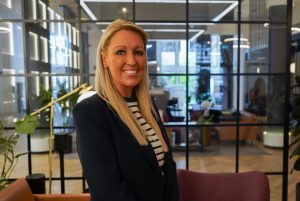Transformation projects, being deliberate is absolutely key

In a roundtable discussion held in Liverpool with Grant Thornton we wanted to look at the future of work.
In particular, how it was related to transformation and therefore to explore the constantly evolving environment of how technology drives projects and they integrate around human need.
We touched on how businesses are thinking about how best to use technology, and how this might impact on workforce strategy and most importantly; how you can make transformation successful.
Ben Butterfield of Grant Thornton described the fascinating challenges of implementing change through transformational projects: “What I’ve noticed is that you need to be quite deliberate if you want to be successful.
“Whether you call it sort of Target Operating Model, or business architecture, it’s about being quite deliberate about where you’re trying to get to. That could be physical space, and how some people interact, it could be how technologies integrate, maybe a transition from legacy technologies to more cloud based technologies.
“What I’ve seen is some organisations will sort of treat each thing independently. And perhaps they’ll have individual leaders working over each one, which can be really quite disruptive and creates lots of tension. Whereas if there’s actually time taken by the executive team to really look at where they’re trying to get to, and then design that route, and design that operating model, then it’s all well and good.
“We’re seeing some organisations starting to bring in a chief transformation officer in a role that is independent from from the sort of the operating business and the core executive. That could be someone who comes with the experience of doing the design, but also understanding the change management processes that need to be put in place and the good old fashioned project management processes as well.”
In his experience at private health insurer Medicash, Andy Roberts said planning is key.
“No matter how well you probably plan and you test and you take people through that journey, people only get more receptive to change, the more that they go through it.
I can remember when we first did our first IT system, and that was after we’d been using a legacy system for the previous 17 years. We’d give it lots of time to bed in the new system, we did all the training to try to bring them up to speed. But when it kind of went in, people just didn’t like it at all.
But each time you do something new, you get better at delivering it and managing the rollout of it. But I think as well you notice, the more you do it, the more people become more receptive to the need to keep up and change.
But I do find it interesting, you can almost see throughout the business at the team leader level, who were the team leaders who are open to change and embrace it, the team leaders who don’t stand it, and it almost you can see that direct correlation between the staffers, you know, in terms of it just feeds down. So I think that that’s probably the biggest challenge is yes, you can plan but you do need everyone, particularly people in the senior positions to be receptive to change.
Tania Ellery from System C, who has been involved in change programmes all her professional life, said communications is key: “How do you enable your transformational programme to look like it’s intimate, and it’s personal. And people have enough forums and opportunities to really have a dialogue around that while you’re actually going at breakneck speed.”
Professor Janet Hemingway said her organisation is going through huge change at the moment, but also recognised the impact of everybody talking about AI. “And we’re in that space, we’re also moving with real economies and things like that away from the petrochemical based sort of system, even for personal care products, to biotech. And that brings with it a whole range of new challenges and activities that go there. So what we’re actually trying to do is bring that technology to companies who can’t afford it, or can’t set it up themselves, or don’t necessarily understand it. But you’ve also got a mix of adopters within that space as well.
“I’m probably the oldest person around the table here. There’s an age element in there, too, because years ago, I was an early adopter. Now, and I didn’t find it quite as easy to pick up new systems. I think the truth is that as you age, it gets harder and harder to adopt these sort of things and take these things through.”
“I’m busy putting in big AI and mobile robotic systems at the moment, and everybody’s saying, what’s that going to do to people’s jobs. And it is going to change them without them. But it will take away routine, mundane operations and allow people to use their brains more.”
Ben Butterfield finished off the discussion by saying the biggest risk is short termism.
“Organisations can get the quick of cost savings by reducing headcount, because it’s measurable, but then they lose that corporate memory that goes with people. It is also really difficult and expensive to recruit.
“It’s something that always worries me when, when we’re working on transformation plans.”








